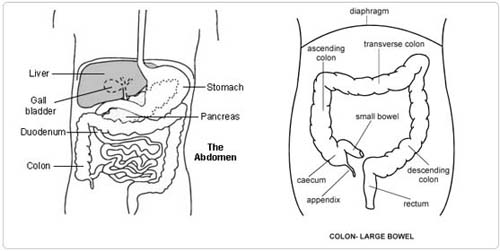What is it?
As you know, you have a colostomy. This is an opening of the bowel. It drains waste out onto the skin, instead of down the normal way into the back passage. By now you have had tests which show that it is time to close off the colostomy. The waste will again run into the back passage.

The Operation
You will have a general anaesthetic, and will be asleep for the whole operation. A cut is made around the colostomy to free the bowel from the skin and the body wall. The opening in the bowel is then joined up again inside the tummy, or sealed off, so that the waste will drain the normal way to the back passage. The wound where the colostomy once was, is then closed off. Sometimes the main wound in your tummy has to be reopened to join the bowel up properly. The wound is stitched up again at the end of the operation. You should plan to leave hospital 7 days after the operation. If you have had the main wound reopened, plan for 10 days in hospital.
Any Alternatives
Leaving the colostomy as it is is clearly an option. You do not put yourself at risk by keeping the colostomy. There is a way of closing the colostomy using a special clamp. This avoids an operation, but often leaves a troublesome weakness under the scar.
Before the operation
Stop smoking and try to get your weight down if you are overweight. If you know that you have problems with your blood pressure, your heart, or your lungs, ask your family doctor to check that these are under control. Check the hospital's advice about taking the pill or hormone replacement therapy (HRT). Check you have a relative or friend who can come with you to hospital, take you home, and look after you for the first week after the operation. Sort out any tablets, medicines, inhalers that you are using. Keep them in their original boxes and packets. Bring them to hospital with you.
On the ward, you may be checked for past illnesses and may have special tests, ready for the operation. Please tell the nurses of any allergies to tablets, medicines or dressings. You will have the operation explained to you and will be asked to fill in an operation consent form. Many hospitals now run special preadmission clinics, where you visit for an hour or two, a few weeks or so before the operation for these checks.
After - In Hospital
You may have a drip tube in an arm vein connected to a plastic bag on a stand containing a salt solution or blood. You may have a fine plastic tube coming out of your nose and connected to another plastic bag to drain your stomach. Swallowing may be a little uncomfortable. You may have a fine tube (catheter) passing into the bladder through the front passage. This lets the bladder stay empty and small during the operation and helps control your body fluids afterwards. You will have a dressing on your wound(s) and perhaps a drainage tube coming out of the skin. You may be given oxygen from a face mask for a few hours if you have had chest problems in the past. The wound is painful and you will be given injections and later tablets to control this. Ask for more if the pain is still unpleasant. A general anaesthetic will make you slow, clumsy and forgetful for about 24 hours. Do not make important decisions during that time.
You will be expected to get out of bed the day after the operation despite the discomfort. You will not do the wound any harm, and the exercise is very helpful for you. The second day after operation you should be able to spend an hour or two out of bed. By the end of four days you should have little pain. Opening the bowels may take a day or two. The bowel motion may be rather loose for a week or so at first. Because of the drainage tube (catheter) in the bladder, passing urine is not a problem. Once you can walk about in reasonable comfort, the catheter is taken out. The wound has a dressing which may show some staining with old blood in the first 24 hours. You can take the dressing off after 48 hours. There is no need for a dressing after this unless the wound is painful when rubbed by clothing. There may be stitches or clips in the skin. The wound may be held together underneath the skin and does not need further attention. The same applies if the main wound has been reopened. Sometimes, however, 7 or 8 stitches are put across that wound to add strength. They are removed after about 8 days. The drain tube is removed after about 4 days. There may be some purple bruising around the wound which spreads downwards by gravity and fades to a yellow colour after 2 to 3 days. It is not important.
There may be some swelling of the surrounding skin which also improves in 2 to 3 days. After 7 to 10 days, slight crusts on the wound will fall off. Occasionally minor matchhead sized blebs form on the wound line. These settle down after discharging a blob of yellow fluid for a day or so. You can wash the wound area as soon as the dressing has been removed. Soap and warm tap water are entirely adequate. Salted water is not necessary. You can shower or bath as often as you want. You will be given an appointment to visit the Out Patient Department for a check up about one month after you leave hospital. The nurses will advise about sick notes, certificates etc.
After - At Home
You are likely to feel very tired and need rests 2 or 3 times a day for two weeks or so. You will gradually improve so that by the time a month has passed you will be able to return completely to your usual level of activity. You can drive as soon as you can make an emergency stop without discomfort in the wound, i.e. after about 3 weeks. You can restart sexual relations within 2 or 3 weeks when the wound is comfortable enough. You should be able to return to a light job after about 6 weeks and any heavy job within 8 weeks, or 12 weeks if the main wound was reopened.
Possible Complications
Complications are unusual but are rapidly recognised and dealt with by the nursing and surgical staff. If you think that all is not well, please ask the nurses or doctors. Chest infections may arise, particularly in smokers. Do not smoke. Occasionally the bowel is slow to start working again. This requires patience. Your food and water intake will continue through your vein tubing. Sometimes there is some discharge from the drain by the wound. This stops given time. Wound infection is sometimes seen. This settles down with antibiotics in a week of two. Aches and twinges may be felt in the wound for up to 6 months. Occasionally there are numb patches in the skin around the wound which get better after 2 to 3 months. Very occasionally the bowel cannot be joined up again. This will be discussed with you. Sometimes there is a weakness where the colostomy has been closed. A rejoin operation may be needed later.
Advanced Reproductive Technology
- In Vitro Fertilisation (IVF)
- Intracytoplasmic Sperm Injection (ICSI)
- Donor egg and embryo programs
- In Vitro Fertilisation (IVF)
- Pre-implantation genetic diagnosis (PGD)
- Surrogacy programs
Dental Videos





